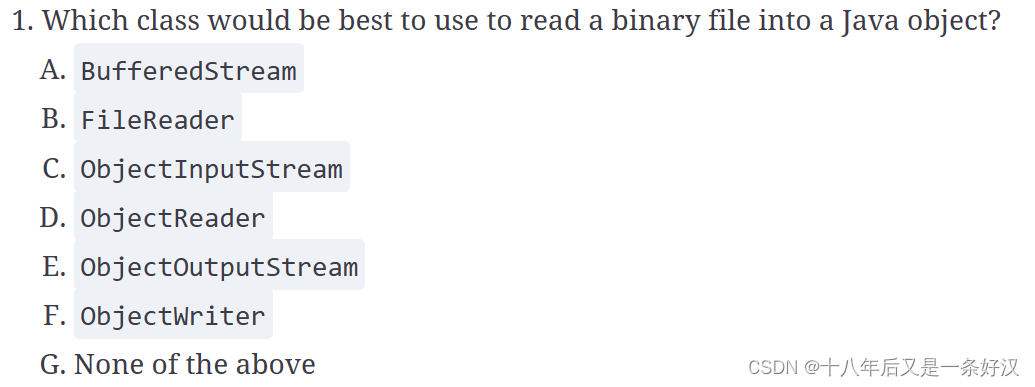
======================= 答案 =======================
======================== ==========================
======================== ==========================
C. Since the question asks about putting data into a structured object, the best class would be one that deserializes the data. Therefore, ObjectInputStream is the best choice, which is option C. ObjectWriter, BufferedStream, and ObjectReader are not I/O stream classes. ObjectOutputStream is an I/O class but is used to serialize data, not deserialize it. FileReader can be used to read text file data and construct an object, but the question asks what would be the best class to use for binary data.
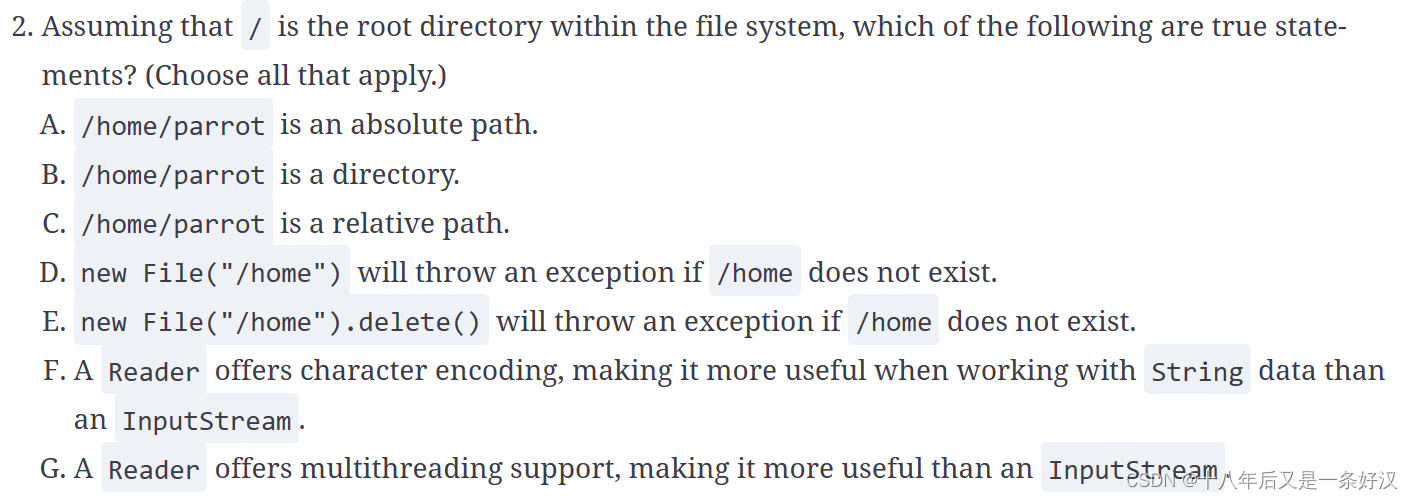
======================= 答案 =======================
======================== ==========================
======================== ==========================
A, F. Paths that begin with the root directory are absolute paths, so option A is correct, and option C is incorrect. Option B is incorrect because the path could be a file or directory within the file system. There is no rule that files have to end with a file extension. Option D is incorrect, as it is possible to create a File reference to files and directories that do not exist. Option E is also incorrect. The delete() method returns false if the file or directory cannot be deleted. Character stream classes often include built-in convenience methods for working with String data, so option F is correct. There is no such optimization for multi-threading, making option G incorrect.
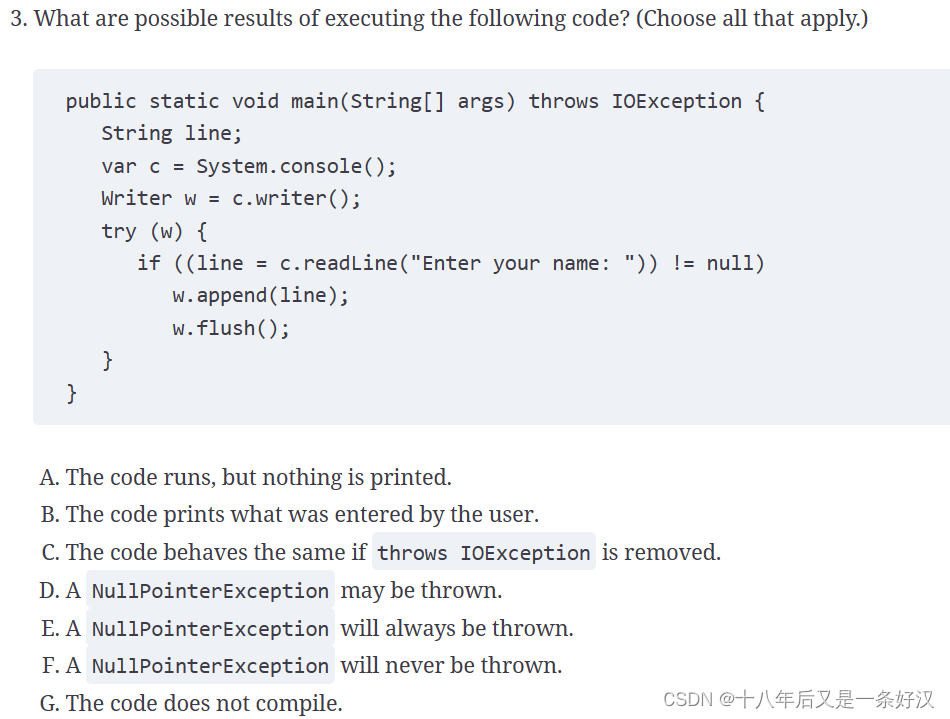
======================= 答案 =======================
======================== ==========================
======================== ==========================
B, D. If the console is unavailable, System.console() will return null, making option D correct and options E and F incorrect. The writer methods throw a checked IOException, making option C incorrect. The code works correctly, prompting for input and printing it. Therefore, option A is incorrect and option B is correct.
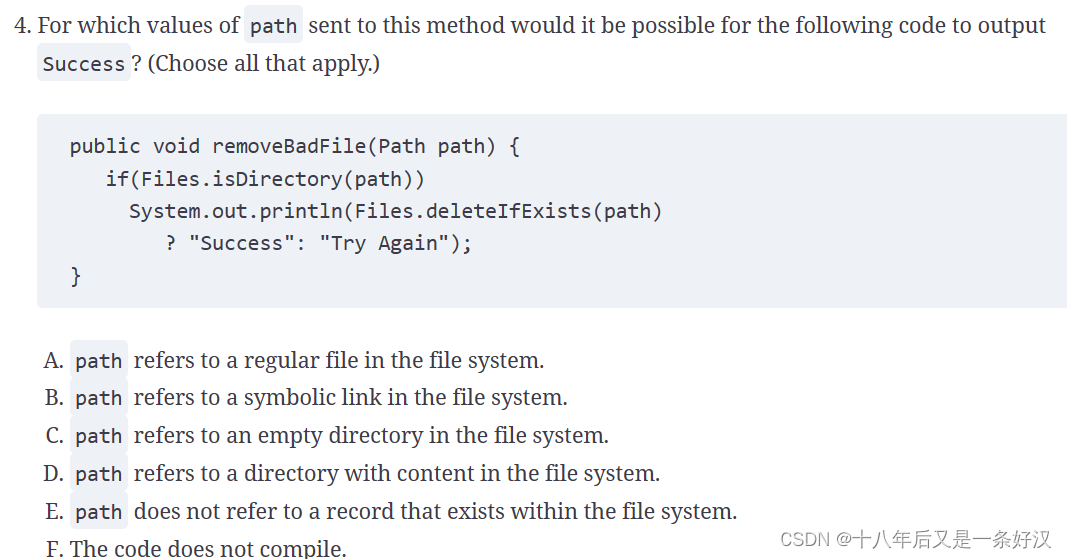
======================= 答案 =======================
======================== ==========================
======================== ==========================
F. The code does not compile, as Files.deleteIfExists() declares the checked IOException that must be handled or declared. Remember, most Files methods declare IOException, especially the ones that modify a file or directory. For this reason, option F is correct. If the method were corrected to declare the appropriate exceptions, option C would be correct. Option B would also be correct if the method were provided a symbolic link that pointed to an empty directory. Options A and E would not print anything, as Files.isDirectory() returns false for both. Finally, option D would throw a DirectoryNotEmptyException at runtime.
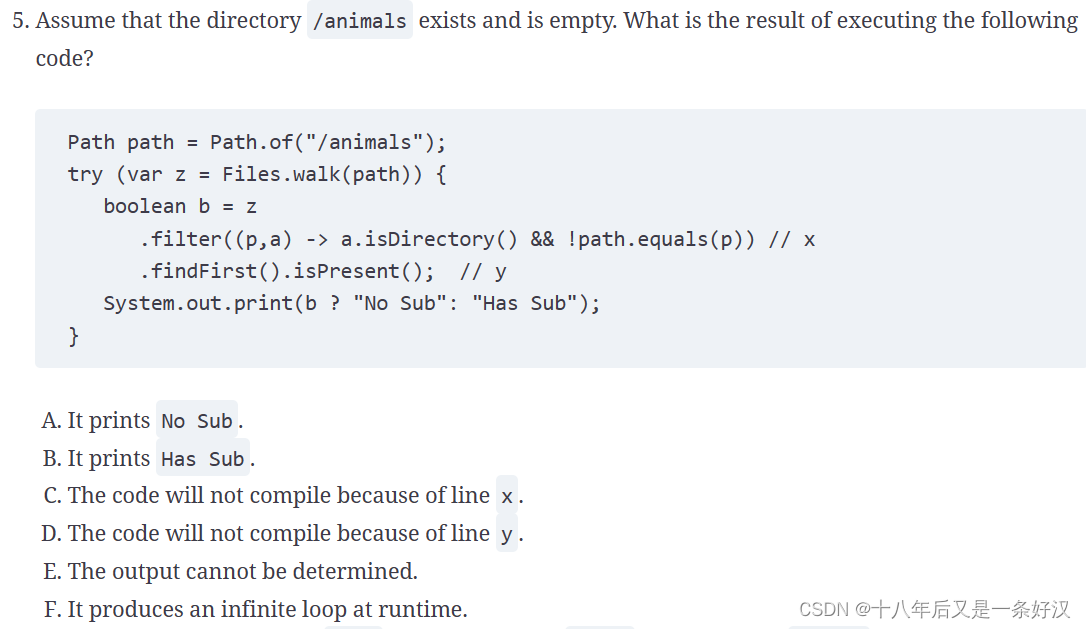
======================= 答案 =======================
======================== ==========================
======================== ==========================
C. The filter() operation applied to a Stream<Path> takes only one parameter, not two, so the code does not compile, and option C is correct. If the code were rewritten to use the Files.find() method with the BiPredicate as input (along with a maxDepth value), the output would be option B, Has Sub, since the directory is given to be empty. For fun, we reversed the expected output of the ternary operation.
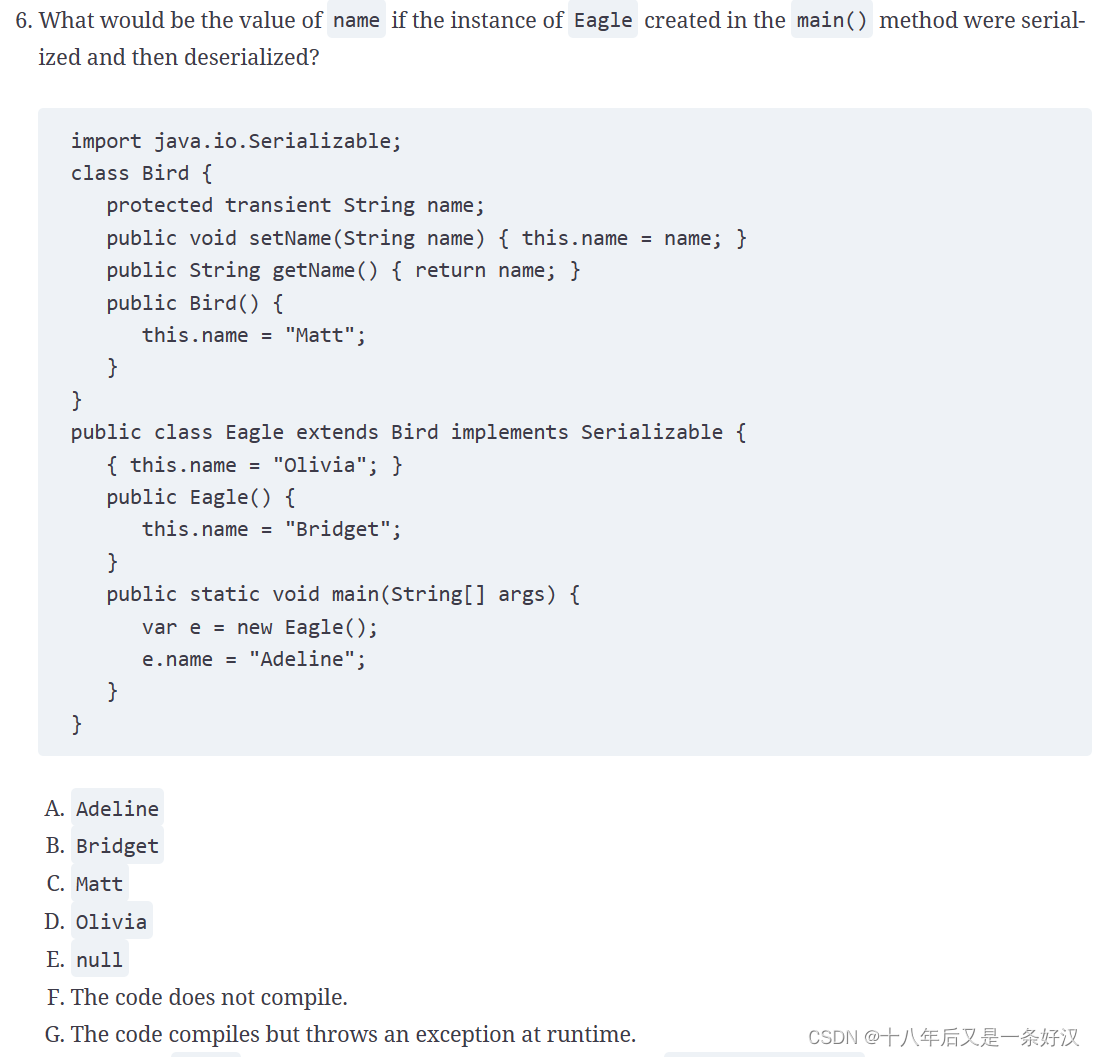
======================= 答案 =======================
======================== ==========================
======================== ==========================
C. The code compiles and runs without issue, so options F and G are incorrect. The key here is that while Eagle is serializable, its parent class, Bird, is not. Therefore, none of the members of Bird will be serialized. Even if you didn't know that, you should know what happens on deserialization. During deserialization, Java calls the constructor of the first non-serializable parent. In this case, the Bird constructor is called, with name being set to Matt, making option C correct. Note that none of the constructors or instance initializers in Eagle are executed as part of deserialization.
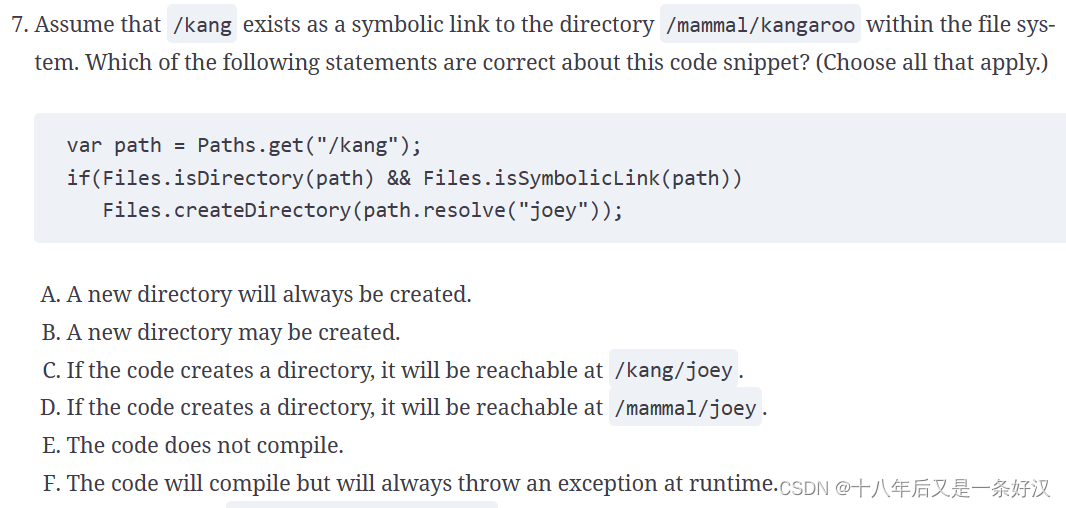
======================= 答案 =======================
======================== ==========================
======================== ==========================
B, C. The code snippet will attempt to create a directory if the target of the symbolic link exists and is a directory. If the directory already exists, though, it will throw an exception. For this reason, option A is incorrect, and option B is correct. It will be created in /mammal/kangaroo/joey and also reachable at /kang/joey because of the symbolic link, making option C correct.
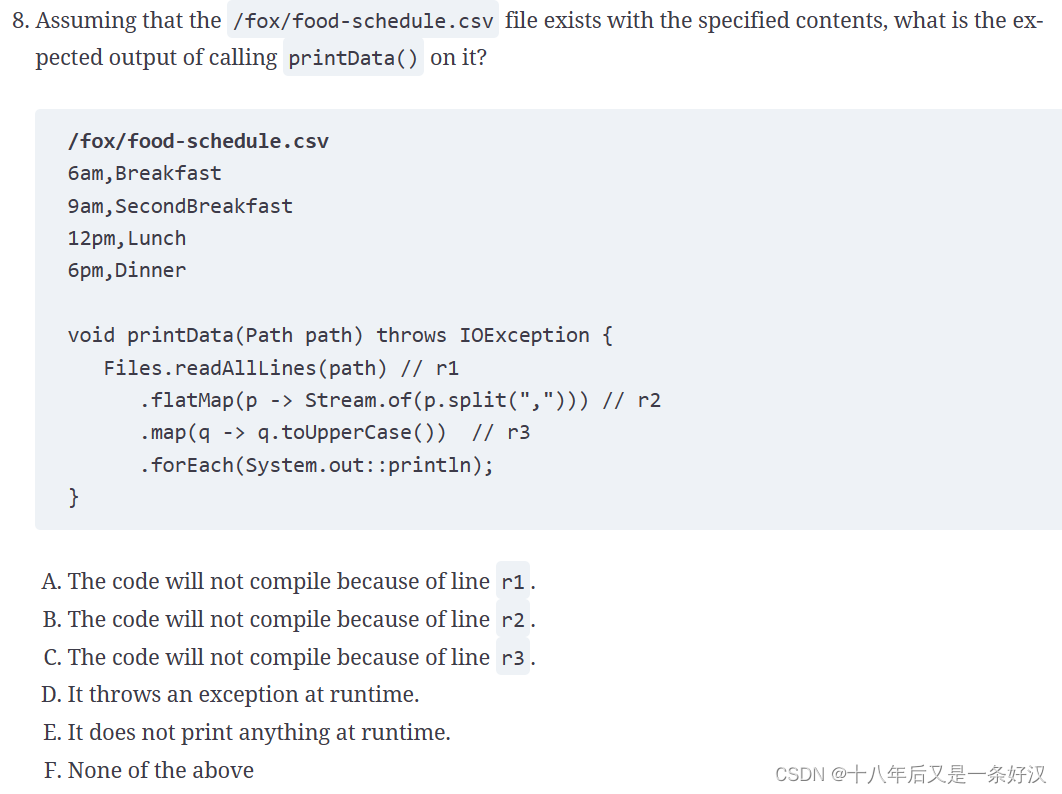
======================= 答案 =======================
======================== ==========================
======================== ==========================
B. The readAllLines() method returns a List, not a Stream. Therefore, the call to flatMap() is invalid, and option B is correct. If the Files.lines() method were used instead, it would print the contents of the file one capitalized word at a time with the commas removed.

======================= 答案 =======================
======================== ==========================
======================== ==========================
C, E, G. First, the method does compile, so options A and B are incorrect. Methods to read/write byte[] values exist in the abstract parent of all I/O stream classes. This implementation is not correct, though, as the return value of read(buffer) is not used properly. It will only correctly copy files whose character count is a multiple of 10, making option C correct and option D incorrect. Option E is also correct as the data may not have made it to disk yet. Option F would be correct if the flush() method were called after every write. Finally, option G is correct as the reader stream is never closed.
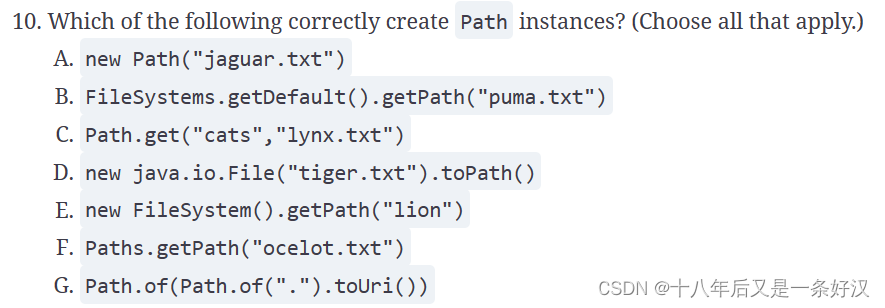
======================= 答案 =======================
======================== ==========================
======================== ==========================
B, D, G. Options A and E are incorrect because Path and FileSystem, respectively, are abstract types that should be instantiated using a factory method. Option C is incorrect because the static method in the Path interface is of(), not get(). Option F is incorrect because the static method in the Paths class is get(), not getPath(). Options B and D are correct ways to obtain a Path instance. Option G is also correct, as there is an overloaded static method in Path that takes a URI instead of a String.
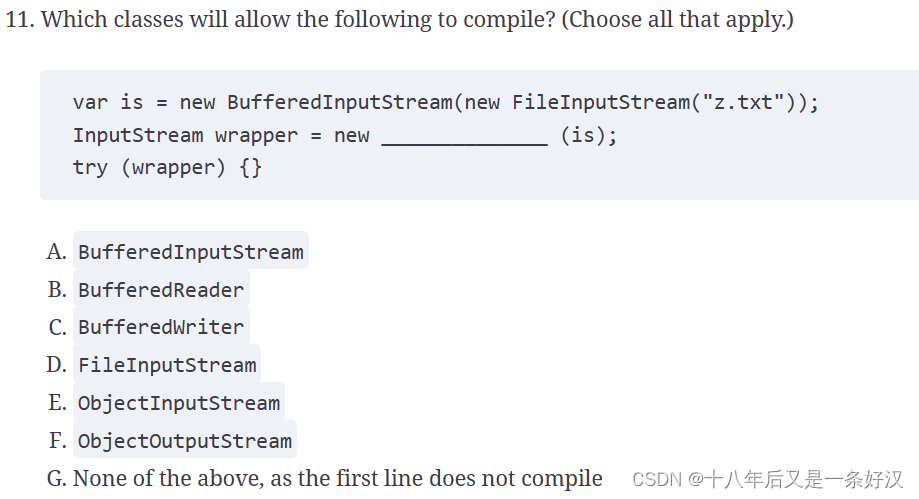
======================= 答案 =======================
======================== ==========================
======================== ==========================
A, E. The code will compile if the correct classes are used, so option G is incorrect. Remember, a try-with-resources statement can use resources declared before the start of the statement. The reference type of wrapper is InputStream, so we need a class that inherits InputStream. We can eliminate BufferedWriter, ObjectOutputStream, and BufferedReader since their names do not end in InputStream. Next, we see the class must take another stream as input, so we need to choose the remaining streams that are high-level streams. BufferedInputStream is a high-level stream, so option A is correct. Even though the instance is already a BufferedInputStream, there's no rule that it can't be wrapped multiple times by a high-level stream. Option D is incorrect, as FileInputStream operates on a file, not another stream. Finally, option E is correct—an ObjectInputStream is a high-level stream that operates on other streams.
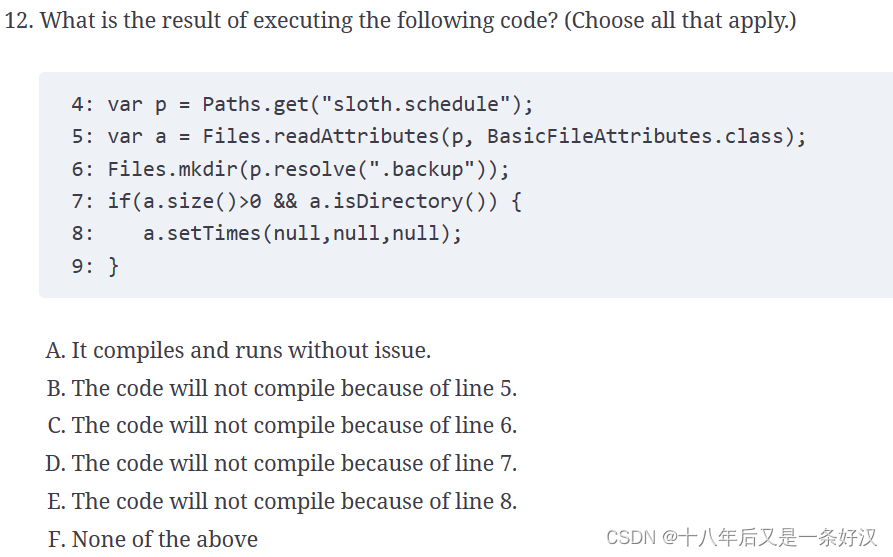
======================= 答案 =======================
======================== ==========================
======================== ==========================
C, E. The method to create a directory in the Files class is createDirectory(), not mkdir(). For this reason, line 6 does not compile, and option C is correct. In addition, the setTimes() method is available only on BasicFileAttributeView, not the read-only BasicFileAttributes, so line 8 will also not compile, making option E correct.

======================= 答案 =======================
======================== ==========================
======================== ==========================
A, G. For a class to be serialized, it must implement the Serializable interface and contain instance members that are serializable or marked transient. For these reasons, options A and G are correct and option F is incorrect. Option B is incorrect because even records are required to implement Serializable to be serialized. Option C is incorrect because it describes deserialization. The Serializable interface is a marker interface that does not contain any abstract methods, making option D incorrect. While it is a good practice for a serializable class to include a static serialVersionUID variable, it is not required. Therefore, option E is incorrect as well.
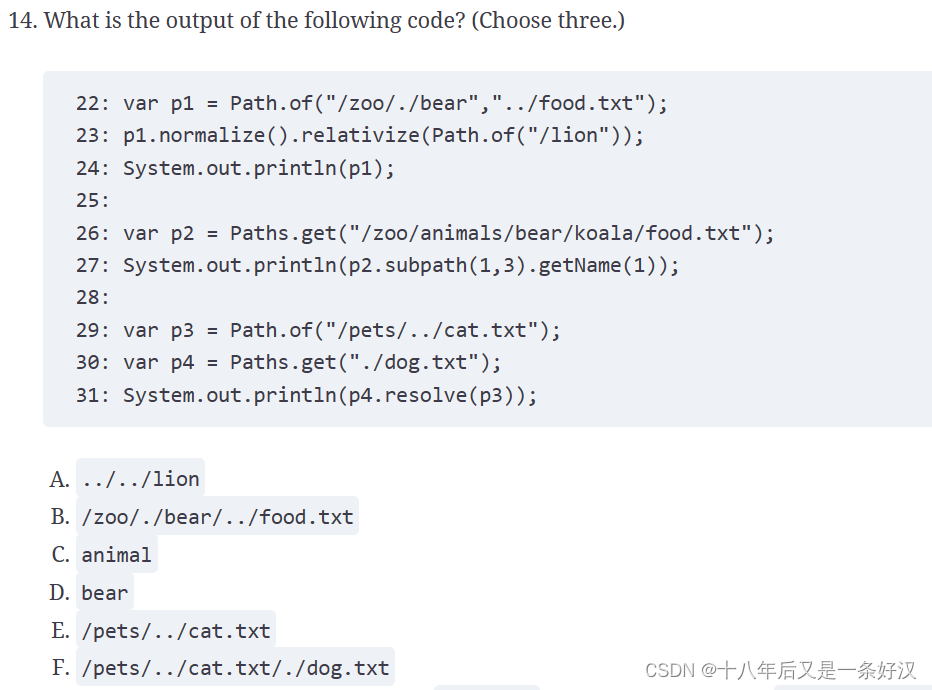
======================= 答案 =======================
======================== ==========================
======================== ==========================
B, D, E. Path is immutable, so line 23 is ignored. If it were assigned to p1, option A would be correct. Since it is not assigned, the original value is still present, which is option B. Moving on to the second section, the subpath() method on line 27 is applied to the absolute path, which returns the relative path animals/bear. Next, the getName() method is applied to the relative path, and since this is indexed from 0, it returns the relative path bear. Therefore, option D is correct. Finally, remember calling resolve() with an absolute path as a parameter returns the absolute path, so option E is correct.
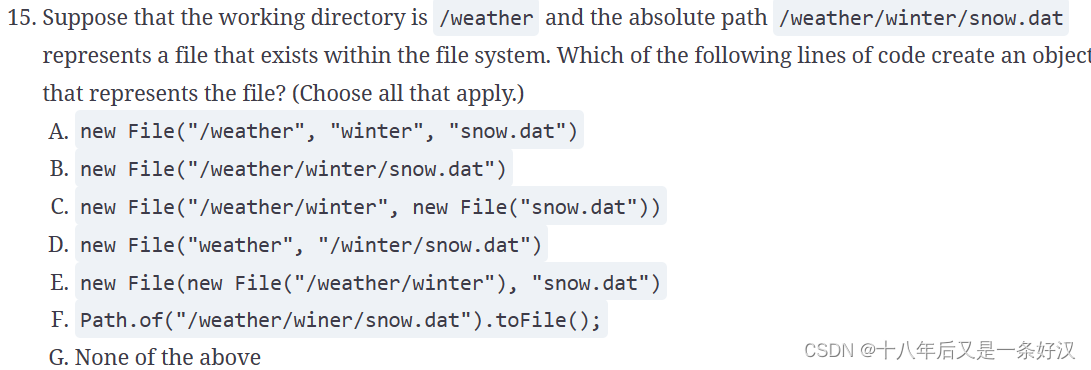
======================= 答案 =======================
======================== ==========================
======================== ==========================
B, E, F. Option A does not compile, as there is no File constructor that takes three parameters. Option B is correct and is the proper way to create a File instance with a single String parameter. Option C is incorrect, as there is no constructor that takes a String followed by a File. There is a constructor that takes a File followed by a String, making option E correct. Option D is incorrect because the first parameter is missing a slash (/) to indicate it is an absolute path. Since it's a relative path, it is correct only when the user's current directory is the root directory. Finally, option F is correct as it creates a File from a Path.
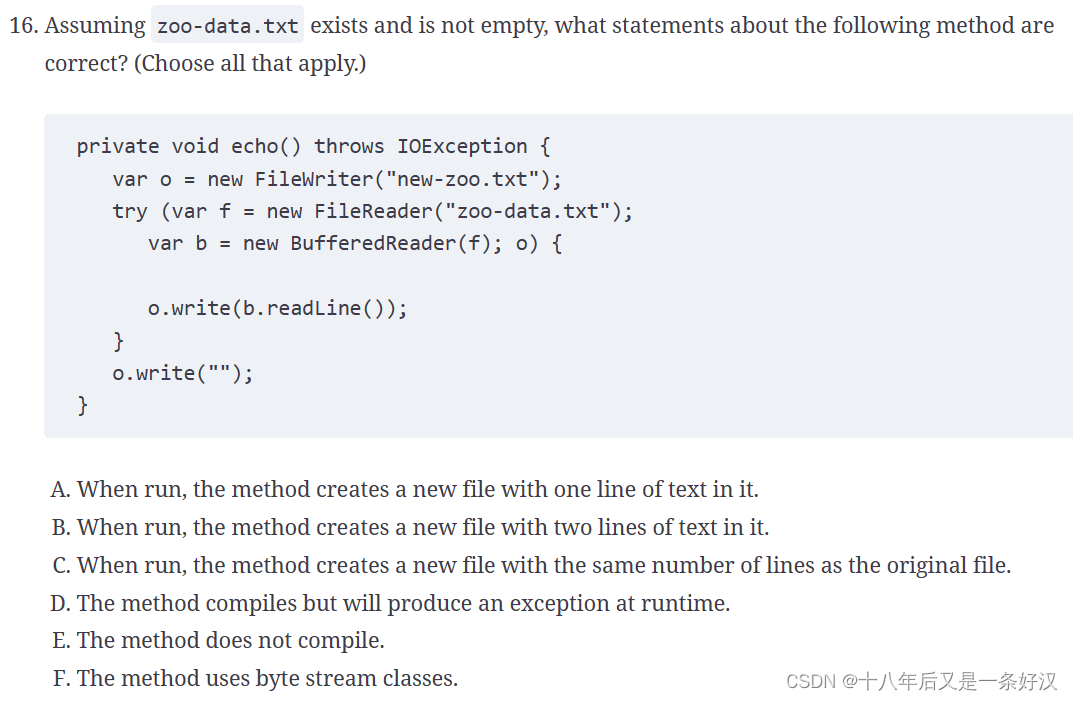
======================= 答案 =======================
======================== ==========================
======================== ==========================
A, D. The method compiles, so option E is incorrect. The method creates a new-zoo.txt file and copies the first line from zoo-data.txt into it, making option A correct. The try-with-resources statement closes all of the declared resources, including the FileWriter o. For this reason, the Writer is closed when the last o.write() is called, resulting in an IOException at runtime and making option D correct. Option F is incorrect because this implementation uses the character stream classes, which inherit from Reader or Writer.

======================= 答案 =======================
======================== ==========================
======================== ==========================
B, C, E. Options B and C are properties of NIO.2 and are good reasons to use it over the java.io.File class. Option A is incorrect as both APIs can delete only empty directories, not a directory tree. Using a view to read multiple attributes leads to fewer round trips between the process and the file system and better performance, making option E correct. Views can be used to access file system–specific attributes that are not available in Files methods; therefore, option D is correct. Files is part of NIO.2, whereas File is part of java.io, which means option F is incorrect.

======================= 答案 =======================
======================== ==========================
======================== ==========================
C. Since a Reader may or may not support mark(), we can rule out options E, F, G, and H. Assuming mark() is supported, P is added to the StringBuilder first. Next, the position in the stream is marked before E. The E is added to the StringBuilder, with AC being skipped, and then the O is added to the StringBuilder, with CK being skipped. The stream is then reset() to the position before the E. The call to skip(0) doesn't do anything since there are no characters to skip, so E is added onto the StringBuilder in the next read() call. The value PEOE is printed, and option C is correct.
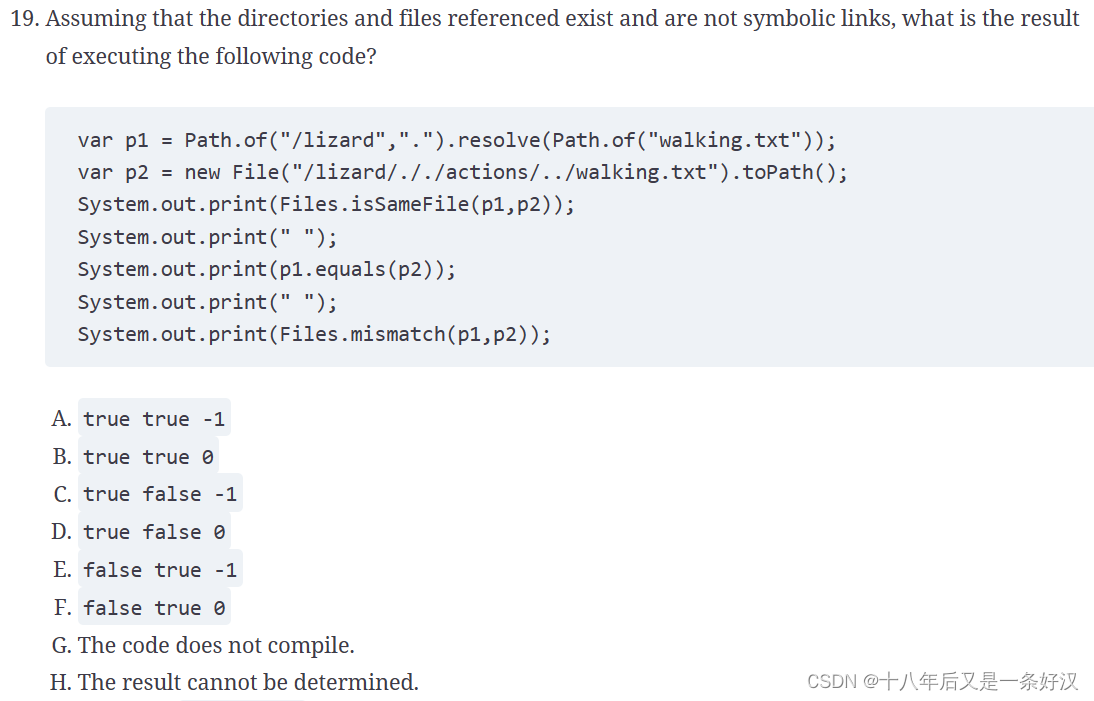
======================= 答案 =======================
======================== ==========================
======================== ==========================
C. The code compiles and runs without issue, so option G is incorrect. If you simplify the redundant path symbols, p1 and p2 represent the same path, /lizard/walking.txt. Therefore, isSameFile() returns true. The second output is false, because equals() checks only if the path values are the same, without reducing the path symbols. Finally, mismatch() sees that the contents are the same and returns -1. For these reasons, option C is correct.
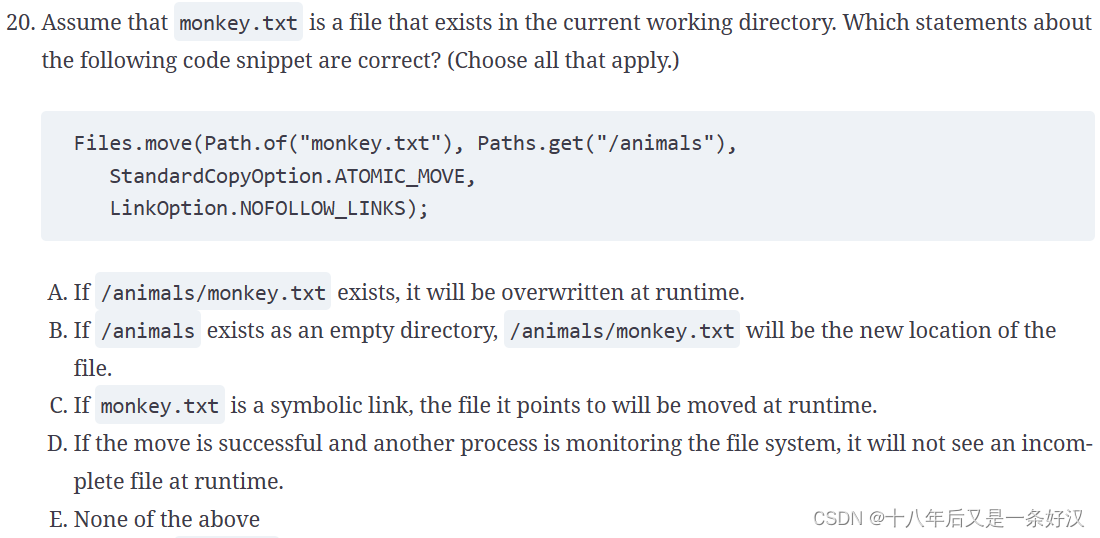
======================= 答案 =======================
======================== ==========================
======================== ==========================
D. The target path of the file after the move() operation is /animals, not /animals/monkey.txt, so options A and B are both incorrect. Both will throw an exception at runtime since /animals already exists and is a directory. Next, the NOFOLLOW_LINKS option means that if the source is a symbolic link, the link itself and not the target will be copied at runtime, so option C is also incorrect. The option ATOMIC_MOVE means that any process monitoring the file system will not see an incomplete file during the move, so option D is correct.

======================= 答案 =======================
======================== ==========================
======================== ==========================
C. The code compiles and runs without issue, so options D, E, and F are incorrect. The most important thing to notice is that the depth parameter specified as the second argument to find() is 0, meaning the only record that will be searched is the top-level directory. Since we know that the top directory is a directory and not a symbolic link, no other paths will be visited, and nothing will be printed. For these reasons, option C is the correct answer.
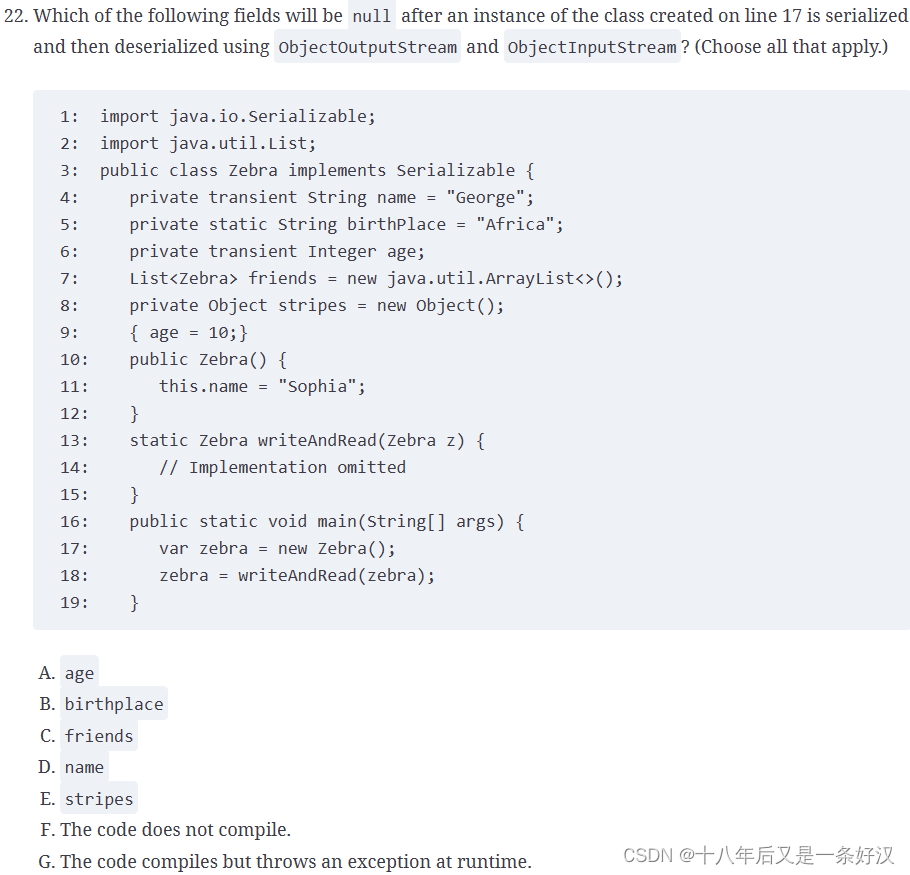
======================= 答案 =======================
======================== ==========================
======================== ==========================
G. The code compiles, so option F is incorrect. To be serializable, a class must implement the Serializable interface, which Zebra does. It must also contain instance members that either are marked transient or are serializable. The instance member stripes is of type Object, which is not serializable. If Object implemented Serializable, all objects would be serializable by default, defeating the purpose of having the Serializable interface. Therefore, the Zebra class is not serializable, with the program throwing an exception at runtime if serialized and making option G correct. If stripes were removed from the class, options A and D would be the correct answers, as name and age are both marked transient.

======================= 答案 =======================
======================== ==========================
======================== ==========================
A, D. The code compiles without issue, so options E and F are incorrect. The toRealPath() method will simplify the path to /animals and throw an exception if it does not exist, making option D correct. If the path does exist, calling getParent() on it returns the root directory. Walking the root directory with the filter expression will print all .java files in the root directory (along with all .java files in the directory tree), making option A correct. Option B is incorrect because it will skip files and directories that do not end in the .java extension. Option C is also incorrect as Files.walk() does not follow symbolic links by default. Only if the FOLLOW_LINKS option is provided and a cycle is encountered will the exception be thrown.
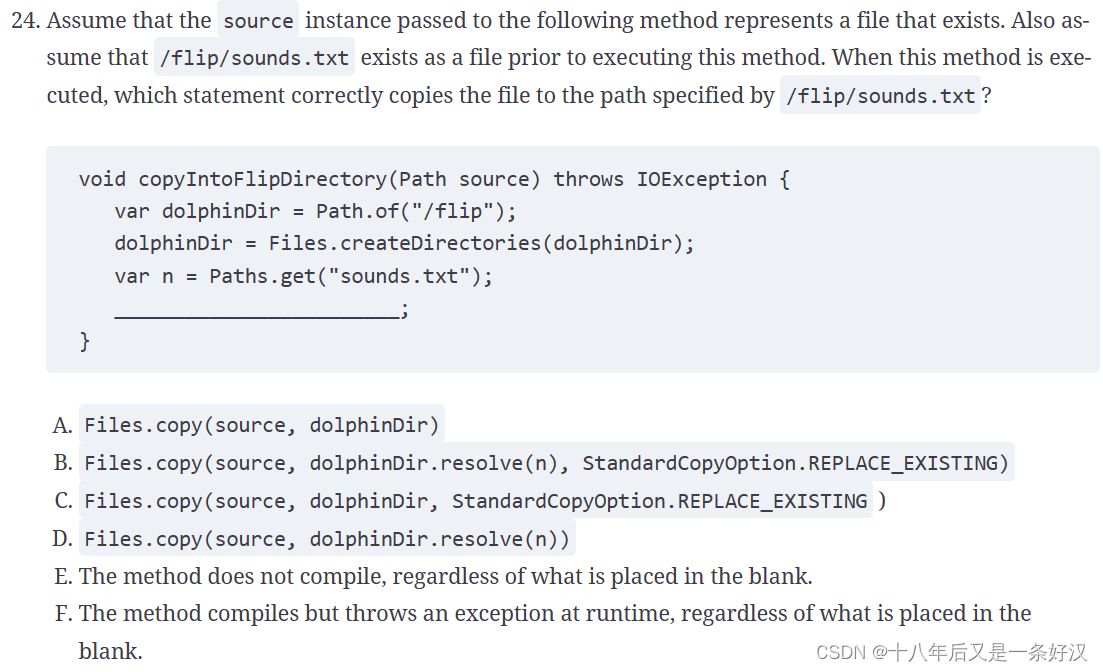
======================= 答案 =======================
======================== ==========================
======================== ==========================
B. The method compiles without issue, so option E is incorrect. Option F is also incorrect. Even though /flip exists, createDirectories() does not throw an exception if the path already exists. If createDirectory() were used instead, option F would be correct. Next, the copy() command takes a target that is the path to the new file location, not the directory to be copied into. Therefore, the target path should be /flip/sounds.txt, not /flip. For this reason, options A and C are incorrect. Since the question says the file already exists, the REPLACE_EXISTING option must be specified or an exception will be thrown at runtime, making option B the correct answer.

======================= 答案 =======================
======================== ==========================
======================== ==========================
B, D. Since you need to read characters, the Reader classes are appropriate. Therefore, you can eliminate options A, C, and F. Additionally, options E and G are incorrect, as they reference classes that do not exist. Options B and D are correct since they read from a file and buffer for performance.















![[大模型]Qwen-7B-Chat WebDemo](http://pic.xiahunao.cn/[大模型]Qwen-7B-Chat WebDemo)



